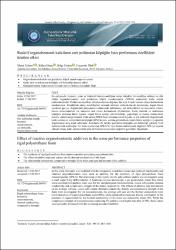Reaktif organobentonit katkıların sert poliüretan köpüğün bazı performans özellikleri üzerine etkisi
Özet
Bu çalışmada; bentonit, amin ve hidroksil fonksiyonelliğine sahip bileşikler ile modifiye edilmiş ve eldeedilen organobentonitler sert poliüretan köpük nanokompozit (SPKN) sentezinde katkı olarakkullanılmışlardır. Poliüretan matrikste kil tabakalarının dağılımı dar açılı X-ışını kırınım cihazı kullanılarak incelenmiştir. Köpüklerin yüzey morfolojileri taramalı elektron mikroskobu ile incelenmiş, kapalı hücreiçerikleri gaz yer değiştirmeli piknometre kullanılarak belirlenmiş, ısıl iletkenlikleri ısı akış metre cihazı,basma mukavemetleri ise üniversal test cihazı kullanılarak ölçülmüştür. Katkı türünün ve miktarınınköpüğün ortalama hücre boyutu, kapalı hücre içeriği, ısıl iletkenliği, yoğunluğu ve basma mukavemetiüzerine etkileri araştırılmıştır. Elde edilen SPKN'lerin ortalama hücre boyutu ve ısıl iletkenlik değerlerindekatkı içermeyen sert poliüretan köpüğe (SPK) kıyasla azalma gözlenirken, kapalı hücre içeriği ve yoğunluk değerlerinde artış tespit edilmiştir. Katkılama ile birlikte poliüretan köpüğün ısıl iletkenliği yaklaşık %10mertebesinde azalmıştır. %1 katkı içeren tüm SPKN'ler için basma mukavemeti değerleri SPK'ye kıyaslayüksek olmuş, katkı miktarındaki artış ile birlikte mukavemet değerleri genellikle düşmüştür In this study, bentonite was modified with the compounds which have amine and hydroxyl functionality andobtained organobentonites were used as additive for the synthesis of rigid polyurethane foamnanocomposites (SPKN). The dispersion of clay layers into the polyurethane matrix was investigated usinga small angle X-ray diffractometer. A Scanning electron microscope, a gas pycnometer, a heat flow meterand a universal test machine were used for the morphological characterization, closed cell content, thermal conductivity and compressive strength of the foams, respectively. The effects of additive type and amounton the average cell size, closed cell content, thermal conductivity, density and compressive strength of thefoam were investigated. For all nanocomposites, the average cell size and the thermal conductivity werelower than those of rigid polyurethane foam (SPK), while closed cell content and density were higher. In thepresence of organobentonite, the thermal conductivity of the foam was reduced by about 10%. While the compressive strength of nanocomposites containing 1% additive were higher than that of SPK, these valueswere generally decreased with the increasing amount of additive
Kaynak
Gazi Üniversitesi Mühendislik Mimarlık Fakültesi DergisiCilt
32Sayı
4Bağlantı
http://www.trdizin.gov.tr/publication/paper/detail/TWpZM05ERTFOUT09https://hdl.handle.net/11421/17885


















